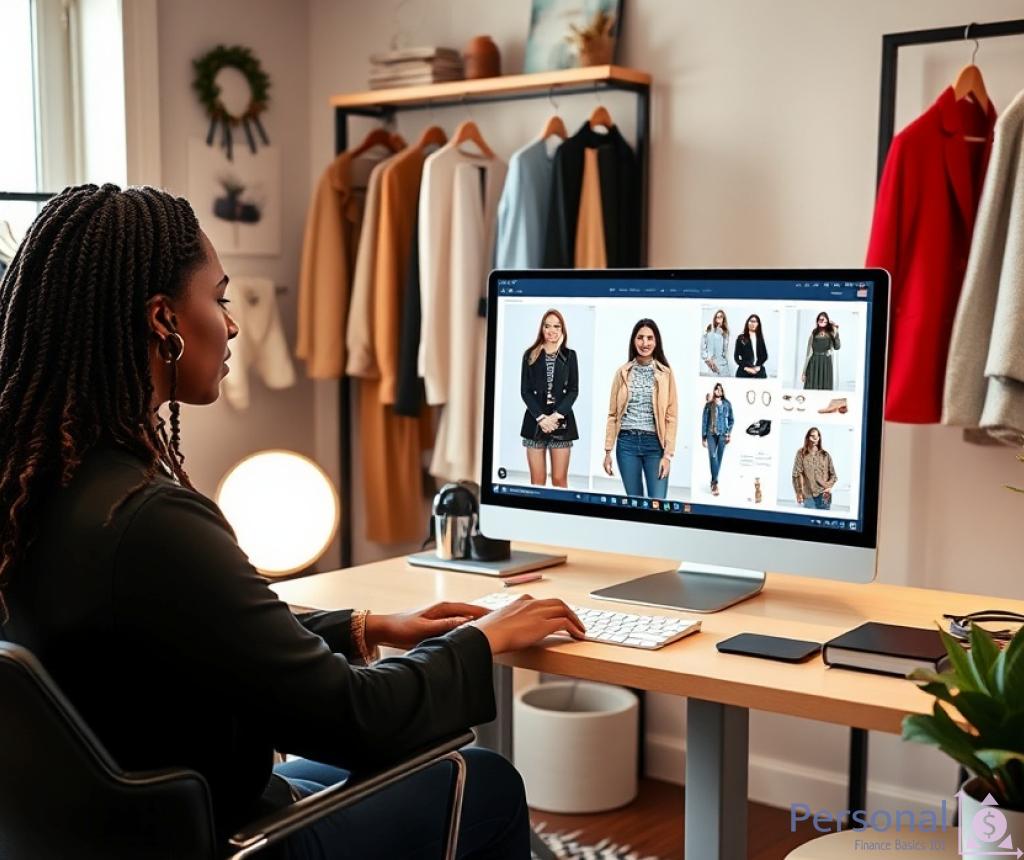Understanding the Virtual Personal Styling Market

The Rise of Virtual Personal Styling
In an era where digital services are rapidly evolving, the fashion industry is not left behind. Virtual personal styling has emerged as a lucrative side business, catering to a diverse clientele that seeks personalized fashion advice without the constraints of geography. The convenience of online shopping, combined with the demand for individualized style guidance, has paved the way for personal stylists to thrive in the virtual space.
Market Dynamics and Opportunities
The virtual personal styling market is characterized by its adaptability and access to a broad audience. With platforms like Instagram and TikTok influencing fashion trends, personal stylists can leverage social media to attract clients. This section explores the key dynamics that shape this market.
| Market Dynamics | Opportunities |
|---|---|
| Increased Online Shopping | Target consumers who prefer online shopping experiences. |
| Social Media Influence | Utilize platforms for marketing and showcasing styling skills. |
| Diverse Clientele | Offer services tailored to various demographics and fashion needs. |
| Technological Advancements | Utilize virtual fitting rooms and AI tools for enhanced service. |
Essential Skills for Success
Entering the virtual personal styling arena requires more than just an eye for fashion. Successful stylists possess a unique blend of skills that not only enhance their service offerings but also foster long-term client relationships. Below is a summary of essential skills that can set a virtual stylist apart in a competitive market.
- Fashion Knowledge: Understanding current trends, fabrics, and body types.
- Communication Skills: Effectively conveying style ideas and engaging with clients.
- Technical Proficiency: Familiarity with online tools and platforms for styling and marketing.
- Business Acumen: Ability to manage finances, marketing, and customer service.
Building Your Online Presence as a Stylist
In today’s digital age, establishing a solid online presence is crucial for virtual personal stylists aiming to attract and retain clients. As a stylist, your online persona is not just a representation of your fashion expertise but also a platform where potential clients can engage with your services. This section delves into effective strategies for crafting a compelling online identity that resonates with your target audience.
Curating Your Digital Portfolio
Your portfolio serves as a visual resume, showcasing your styling capabilities and aesthetic. A well-curated digital portfolio not only highlights your best work but also reflects your unique style and approach. Here are some key elements to consider:
- High-Quality Images: Invest in professional photography to capture your styling work in detail.
- Diversity in Styling: Include a range of styles that cater to different demographics and occasions.
- Client Testimonials: Feature feedback from satisfied clients to build credibility and trust.
- Behind-the-Scenes Content: Share insights into your styling process to engage viewers and demonstrate your expertise.
Leveraging Social Media Platforms
Social media has revolutionized the way personal stylists connect with clients. Platforms like Instagram, TikTok, and Pinterest not only allow you to showcase your work but also provide opportunities for interaction and engagement. Here are some strategies to maximize your social media impact:
- Consistent Branding: Maintain a cohesive aesthetic and tone across all platforms to strengthen your brand identity.
- Engaging Content: Create a mix of educational posts, styling tips, and personal anecdotes to resonate with your audience.
- Collaborations: Partner with influencers or other stylists to expand your reach and attract new followers.
- Utilize Hashtags: Research and use relevant hashtags to increase the visibility of your posts.
Creating a User-Friendly Website
A professional website acts as a central hub for your virtual styling business. It should provide visitors with easy access to your portfolio, services, and contact information. Here are essential components of an effective stylist website:
| Essential Components | Description |
|---|---|
| Portfolio Section | Showcase your best work with high-quality images and detailed descriptions. |
| Service Offerings | Clearly outline the services you provide, including pricing and packages. |
| Blog or Style Tips | Share insights, trends, and styling advice to engage visitors and enhance SEO. |
| Contact Information | Provide easy access to your email, social media links, and a contact form for inquiries. |
By implementing these strategies, virtual personal stylists can effectively build their online presence, engage with potential clients, and establish a brand that resonates within the competitive fashion landscape.
Effective Communication with Clients in a Virtual Setting
In the realm of virtual personal styling, effective communication is the cornerstone of successful client relationships. Unlike traditional face-to-face interactions, virtual communication requires a more nuanced approach to ensure that style advice resonates with clients. This section explores the essentials of establishing clear and engaging communication channels that foster trust and understanding.
Mastering the Art of Virtual Dialogue
Virtual communication is inherently different from in-person discussions, necessitating stylists to adapt their dialogue techniques. The subtleties of body language and tone may be lost in a digital format, making it essential to utilize various tools and methods to convey messages effectively. Here, we’ll delve into techniques that can elevate your communication skills in a virtual context.
Key Techniques for Effective Client Communication
To cultivate a strong rapport with clients, virtual stylists must employ a variety of communication techniques. These methods not only enhance client satisfaction but also encourage long-term partnerships. Below is a list of vital strategies to consider:
- Active Listening: Make an effort to truly hear what your clients are saying, asking clarifying questions to ensure understanding.
- Visual Aids: Utilize images, mood boards, or video calls to provide a visual representation of style concepts.
- Follow-up Communication: Regularly check in with clients to gather feedback and adjust services as necessary.
- Clear and Concise Messaging: Avoid jargon and communicate fashion advice in an easily digestible format.
- Empathy and Support: Show genuine interest in your clients’ preferences and concerns, making them feel valued and understood.
Building Trust Through Transparency
Trust is paramount in any relationship, especially in a virtual setting where clients may feel disconnected. Establishing a transparent communication style can mitigate these feelings and foster a sense of security. Here are essential elements to incorporate:
| Element | Description |
|---|---|
| Service Clarity | Clearly define the scope of your services, pricing, and expectations to avoid misunderstandings. |
| Availability | Be upfront about your availability for consultations and responses to inquiries. |
| Feedback Loop | Encourage clients to share their thoughts on your services, reinforcing a two-way communication approach. |
By mastering these communication techniques and building trust through transparency, virtual personal stylists can create lasting relationships with clients. This not only enhances the overall client experience but also positions stylists for sustained success in the competitive landscape of virtual fashion advice.
Creating Personalized Fashion Recommendations
Tailoring Recommendations to Individual Styles
In the dynamic world of virtual personal styling, personalization is the key to standing out in a crowded market. Stylists must go beyond generic advice to create fashion recommendations that resonate with the unique tastes and lifestyles of their clients. By employing a comprehensive understanding of personal style, preferences, and body types, virtual stylists can craft bespoke looks that not only enhance their clients’ appearances but also boost their confidence.
To deliver a truly personalized experience, stylists often begin by conducting detailed consultations. These sessions allow for an intimate understanding of the client’s wardrobe, their fashion inspirations, and any specific challenges they face. Utilizing tools such as style quizzes and mood boards can significantly aid in this process, ensuring that the recommendations align with the client’s aesthetic vision.
Integrating Trend Awareness with Client Preferences
Another crucial aspect of creating personalized fashion recommendations is the ability to seamlessly integrate current trends with individual client preferences. As the fashion landscape evolves rapidly, keeping abreast of emerging styles is paramount for virtual personal stylists. This knowledge not only helps in suggesting trendy pieces but also allows stylists to position their recommendations within the context of a client’s existing wardrobe.
For instance, if a client expresses interest in a particular trend, such as oversized silhouettes, the stylist can suggest ways to incorporate these elements into their wardrobe without completely overhauling their style. By juxtaposing trend awareness with personalization, stylists can empower clients to embrace new looks while staying true to their unique identities.
Navigating the Virtual Realm with Technology
Technology plays a pivotal role in the delivery of personalized fashion recommendations. Virtual stylists can leverage various digital tools, such as augmented reality and virtual fitting rooms, to help clients visualize how suggested outfits will look on them. This not only enhances the client experience but also minimizes the chances of returns due to sizing issues or style mismatches.
By utilizing data analytics, stylists can track client preferences and purchase history, allowing for even more tailored recommendations in the future. This data-driven approach not only fosters a sense of personalization but also builds a lasting relationship between the stylist and the client. As the virtual personal styling industry continues to grow, the ability to create genuinely personalized fashion advice will remain a significant differentiator for successful stylists.
Marketing Strategies for Your Virtual Styling Business
Utilizing Digital Marketing Channels
In the competitive realm of virtual personal styling, effective marketing strategies are paramount for attracting and retaining clients. As stylists operate primarily online, leveraging digital marketing channels can significantly enhance visibility and engagement. From social media platforms to SEO-optimized websites, understanding how to navigate these channels can make a substantial difference in reaching your target audience.
Social media platforms like Instagram, Pinterest, and TikTok are particularly well-suited for showcasing your styling expertise. Regularly posting high-quality content that showcases your work, such as before-and-after transformations or styling tips, can engage current followers while attracting new ones. Moreover, utilizing Instagram Stories or TikTok videos allows you to connect with your audience on a more personal level, fostering a sense of community around your brand.
Building Strategic Partnerships
Collaborations can be a game-changer for virtual stylists looking to expand their reach. By partnering with complementary brands, influencers, or fellow stylists, you can tap into new audiences and enhance your credibility in the industry. For example, collaborating with a fashion brand for a styling project can provide mutual benefits—exposing your services to their clientele while showcasing the brand’s products through your unique styling approach.
Additionally, consider participating in local or virtual events such as fashion shows, webinars, or panel discussions. These opportunities not only allow you to display your expertise but also connect with potential clients and industry professionals. Building a network of contacts can facilitate referrals and new business opportunities.
Creating Compelling Content
Content marketing plays a crucial role in establishing your authority as a virtual stylist. By creating valuable content, such as blog posts, tutorials, or style guides, you can engage potential clients while also improving your website’s SEO. This approach not only drives traffic to your site but also positions you as a trusted resource in the fashion community.
Here is a list of content ideas that can enhance your marketing strategy:
- Fashion Trends Analysis: Write about current trends and how to incorporate them into different wardrobes.
- Styling Tips: Share practical advice on how to style various pieces for different occasions.
- Client Success Stories: Highlight transformations or testimonials from satisfied clients to build trust.
- Behind-the-Scenes Insights: Offer a glimpse into your styling process to engage your audience.
By implementing these comprehensive marketing strategies, virtual personal stylists can effectively carve out their niche in the online fashion landscape, driving growth and success in their side business.
Disclaimer
This article has been created or edited with the support of artificial intelligence and is for informational purposes only. The information provided should not be considered investment advice. Please seek the support of a professional advisor before making any investment decisions.






